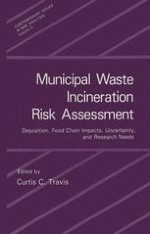The disposal of large quantities of municipal solid waste (MSW) being generated by industrialized countries has become a serious problem. Since it is estimated that within 10 years, half of all municipalities will lack sufficient landfill space, many cities are considering municipal waste combustion as an alternative waste management option.\ Municipal waste combustors have been a source of contention in many local communities and a growing research topic in the scientific community. This book represents a compilation of chapters written by experienced individuals in the areas ofemissions estimation, deposition modeling, risk assessment, indirect exposures, and uncertainty analysis. Estimation of potential human risks associated with pollutants has become an increasing concern. Most often, values required for deposition rates and annual atmospheric concentrations are estimated through the useofatmospheric dispersion models. Chapter 1compares data on the tlatterrain versus the complex terrain dispersion models such as the U.S. EPA Industrial Source Complex Short Term (ISCST) and Long Term (lSCLT). Chapter 2 focuses on the modeling of atmospheric dispersion and dry deposition of fine particulates. A specific size particle (10-20 urn) is used because of its relevance to municipal waste facilities since best available control technology effectively removes particulates above this size range. The deposition ofmaterials from the atmosphere is a critical link in the pathway by which toxic atmospheric pollutants are transported to the surface of food chain components. Chapter 3 describes the importance accounting for wet deposition in risk assessments of municipal waste incinerators.
